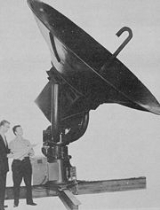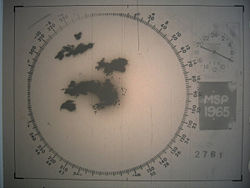
WSR-57
Encyclopedia

Radar
Radar is an object-detection system which uses radio waves to determine the range, altitude, direction, or speed of objects. It can be used to detect aircraft, ships, spacecraft, guided missiles, motor vehicles, weather formations, and terrain. The radar dish or antenna transmits pulses of radio...
for over 35 years. The National Weather Service
National Weather Service
The National Weather Service , once known as the Weather Bureau, is one of the six scientific agencies that make up the National Oceanic and Atmospheric Administration of the United States government...
operated a network of this model radar across the country, watching for severe weather.
History

The WSR-57 was designed in 1957 using World War II technology. It gave only coarse reflectivity data and no velocity data, which made it extremely difficult to predict tornadoes. Weather systems were traced across the radar screen using grease pencils. Forecasters had to manually turn a crank to adjust the radar's scan elevation, and needed considerable skill to judge the intensity of storms based on green blotches on the radar scope.
The military designation for the WSR-57 is AN/FPS-41.
NOAA has interesting pictures of the Charleston, SC WSR-57 radar image of Hurricane Hugo in 1989. At the National Hurricane Center
National Hurricane Center
The National Hurricane Center , located at Florida International University in Miami, Florida, is the division of the National Weather Service responsible for tracking and predicting weather systems within the tropics between the Prime Meridian and the 140th meridian west poleward to the 30th...
(NHC), Hurricane Andrew in 1992 blew the WSR-57 dish off their roof. The NHC report on Hurricane Andrew shows its last radar image, as well as images from nearby WSR-88D radars.
As the network of WSR-57 radars aged, some were replaced with WSR-74
WSR-74
WSR-74 RADARs were Weather Surveillance Radars designed in 1974 for the National Weather Service. They were added to the existing network of the WSR-57 model to improve forecasts and severe weather warnings...
S models of similar performance but with better reliability. WSR-57 operators sometimes had to scramble for spare parts no longer manufactured in this country. One hundred twenty-eight of the WSR-57 and WSR-74
WSR-74
WSR-74 RADARs were Weather Surveillance Radars designed in 1974 for the National Weather Service. They were added to the existing network of the WSR-57 model to improve forecasts and severe weather warnings...
model radars were spread across the country as the National Weather Service's radar network until the 1990s. They were gradually replaced by the WSR-88D model (Weather Surveillance Radar - 1988, Doppler), constituting the NEXRAD
NEXRAD
NEXRAD or Nexrad is a network of 159 high-resolution Doppler weather radars operated by the National Weather Service, an agency of the National Oceanic and Atmospheric Administration within the United States Department of Commerce...
network.
The last WSR-57 radar in the United States was decommissioned on December 2, 1996.
Radar sites
The 66 former sites of the WSR-57 include the following:| Site (Site ID) | Commissioned (Date / Chronological Rank) |
Decommissioned |
|---|---|---|
| Miami, FL (MIA) Moved to Coral Gables in 1967. |
June 26, 1959 1st |
August 24, 1992 Destroyed during Hurricane Andrew Hurricane Andrew Hurricane Andrew was the third Category 5 hurricane to make landfall in the United States, after the Labor Day Hurricane of 1935 and Hurricane Camille in 1969. Andrew was the first named storm and only major hurricane of the otherwise inactive 1992 Atlantic hurricane season... . |
| Kansas City, MO (MCI) The dome still resides downtown. |
1959 2nd |
November 9, 1995 |
| Charleston, SC (CHS) | 1959 About 16th |
December 2, 1996 |
| Key West, FL (EYW?) | Early 1960 Among first 31 |
Early 1980s Replaced by a WSR-74 WSR-74 WSR-74 RADARs were Weather Surveillance Radars designed in 1974 for the National Weather Service. They were added to the existing network of the WSR-57 model to improve forecasts and severe weather warnings... S. |
| Wichita, KS (ICT) | June 22, 1960 Among first 31 |
November 9, 1995 |
| Cincinnati, OH (CVG) (Covington, KY) at the Greater Cincinnati Airport. |
1960 (testing in June) About 16th |
June 21, 1996 |
| St. Louis, MO (STL) | July 1960 Among first 31 |
June 19, 1996 |
| Wilmington, NC (ILM) | Before September 1960 Among first 31 |
November 16, 1995 |
| Tampa Bay Area, FL (TBW) | 1960 Among first 31 |
November 9, 1995 |
| Galveston, TX (GLS) | 1960 Among first 31 |
May 22, 1995 |
| Brownsville, TX (BRO) | March 1961 About 16th |
February 28, 1996 |
| Fort Worth, TX (FTW) moved to Stephenville, TX (SEP) in October 1973. |
April 5, 1961 Among first 31 |
August 1, 1995 |
| Detroit, MI (DET) | September 12, 1961 Among first 31 |
Replaced with a WSR-74 WSR-74 WSR-74 RADARs were Weather Surveillance Radars designed in 1974 for the National Weather Service. They were added to the existing network of the WSR-57 model to improve forecasts and severe weather warnings... S. |
| Amarillo, TX (AMA) | 1961 Among first 31 |
September 15, 1994 |
| Norman, OK - NSSL Research radar; not part of the national network. |
1962? Probably not counted among first 31 |
1980s |
| Catalina Island, CA (STC?) a.k.a. Santa Catalina - atop Blackjack Mountain. |
Early 1963? Among first 31 |
1960's |
| Little Rock, AR (LIT was the WSR-57 designator. LZK is the WSR-88D and WFO Designation.) | 1959 Among first 31 |
Moved to North Little Rock Airport with NWSFO in 1975. Final decommissioning was June 8, 1995 |
| Sacramento, CA (SAC) | Early 1960s Among first 31 |
August 24, 1995 |
| Washington, D.C. (IAD) At Washington Dulles International Airport, Dulles, VA. |
Early 1960s Among first 31 |
Early 1980s Replaced by a WSR-74 WSR-74 WSR-74 RADARs were Weather Surveillance Radars designed in 1974 for the National Weather Service. They were added to the existing network of the WSR-57 model to improve forecasts and severe weather warnings... S at Patuxent River, MD. |
| Apalachicola, FL (AQQ) | Early 1960s Among first 31 |
January 19, 1996 |
| Daytona Beach, FL (DAB) | Early 1960s Among first 31 |
December 1, 1995 |
| Des Moines, IA (DSM) | Early 1960s Among first 31 |
May 7, 1996 |
| Chicago, IL (?) | Early 1960s Among first 31 |
Early 1980s Replaced by a WSR-74 WSR-74 WSR-74 RADARs were Weather Surveillance Radars designed in 1974 for the National Weather Service. They were added to the existing network of the WSR-57 model to improve forecasts and severe weather warnings... S at Marseilles, IL |
| Evansville, IN (EVV) | Early 1960s Among first 31 |
July 12, 1996 |
| Lake Charles, LA (LCH) | Early 1960s Among first 31 |
October 12, 1995 |
| New Orleans, LA (MSY) At Slidell, LA |
Early 1960s Among first 31 |
August 22, 1995 |
| Minneapolis, MN (MSP) At the airport |
Early 1960s Among first 31 |
April 3, 1996 |
| Missoula, MT (MSO) At Point Six Mountain |
Early 1960s Among first 31 |
December 12, 1995 |
| Atlantic City, NJ (ACY) | Early 1960s Among first 31 |
September 13, 1995 |
| New York City, NY (NYC) At 30 Rockefeller Plaza.  |
Early 1960s Among first 31 |
September 26, 1995 |
| Oklahoma City, OK (OKC) | Early 1960s Among first 31 |
July 25, 1994 |
| Portland, ME (?) At Brunswick Naval Air Station |
November 1969 | Replaced by a WSR-74 WSR-74 WSR-74 RADARs were Weather Surveillance Radars designed in 1974 for the National Weather Service. They were added to the existing network of the WSR-57 model to improve forecasts and severe weather warnings... S. |
| Jackson, MS (JAN) At Jackson International Airport at Thompson Field. |
1969 | June 21, 1995 |
| Limon, CO (LIC) | 1960s | December 22, 1995 |
| Garden City, KS (GCK) | 1960s | September 1, 1994 |
| Grand Island, NE (GRI) | 1960s | January 19, 1996 |
| Buffalo, NY (BUF) | 1960s | February 14, 1996 |
| A note on the chronological ranks - The first 31 were built through the early 1960s, at existing Weather Bureau offices. 14 were along the Gulf and Atlantic coasts. 11 were in the Midwest. 3 were inland of the East Coast, and California and Montana had one each on mountaintops. The late 1960s saw 14 more built east of the Rockies. | ||
| Nashville, TN (OHX) At Old Hickory Lake |
November 1970 | January 19, 1996 |
| Memphis, TN (MEG?) At the Millington Naval Air Station. |
February 1971 | December 1985 Replaced by a WSR-74 WSR-74 WSR-74 RADARs were Weather Surveillance Radars designed in 1974 for the National Weather Service. They were added to the existing network of the WSR-57 model to improve forecasts and severe weather warnings... S. |
| Medford, OR (MFR) | June 1971 | August 30, 1996 |
| Centreville, AL (CKL) Next to Brent, AL |
June 27, 1995 | |
| Pensacola, FL (PNS/NPA) | January 19, 1996 | |
| Athens, GA (AHN) | September 13, 1996 | |
| Waycross, GA (AYS) | January 19, 1996 | |
| Cape Hatteras, NC (HAT) | December 6, 1995 | |
| Pittsburgh, PA (PBZ) | May 10, 1995 | |
| Huron, SD (HON) | November 4, 1996 | |
| Bristol, TN (TRI) | January 19, 1996 | |
| Midland/Odessa, TX (MAF) | June 4, 1996 | |
| Neenah, WI (EEW) | 1972? | November 2, 1995 |
| Hondo, TX (HDO) | July 1971 Last (66th) |
March 14, 1996 |
Radar properties
- The radar uses a wavelength of 10.3 cm. This corresponds to an operating frequency of 2890 MHz. This frequency is in the S bandS bandThe S band is defined by an IEEE standard for radio waves with frequencies that range from 2 to 4 GHz, crossing the conventional boundary between UHF and SHF at 3.0 GHz. It is part of the microwave band of the electromagnetic spectrum...
, which is also used by today's weather radar network.
- WSR-57 radars had the following interesting statistics:
- Dish diameter: 12 feet (3.7 m)
- Power output: 410,000 watts
- Maximum range: 915 km (494 nm)

